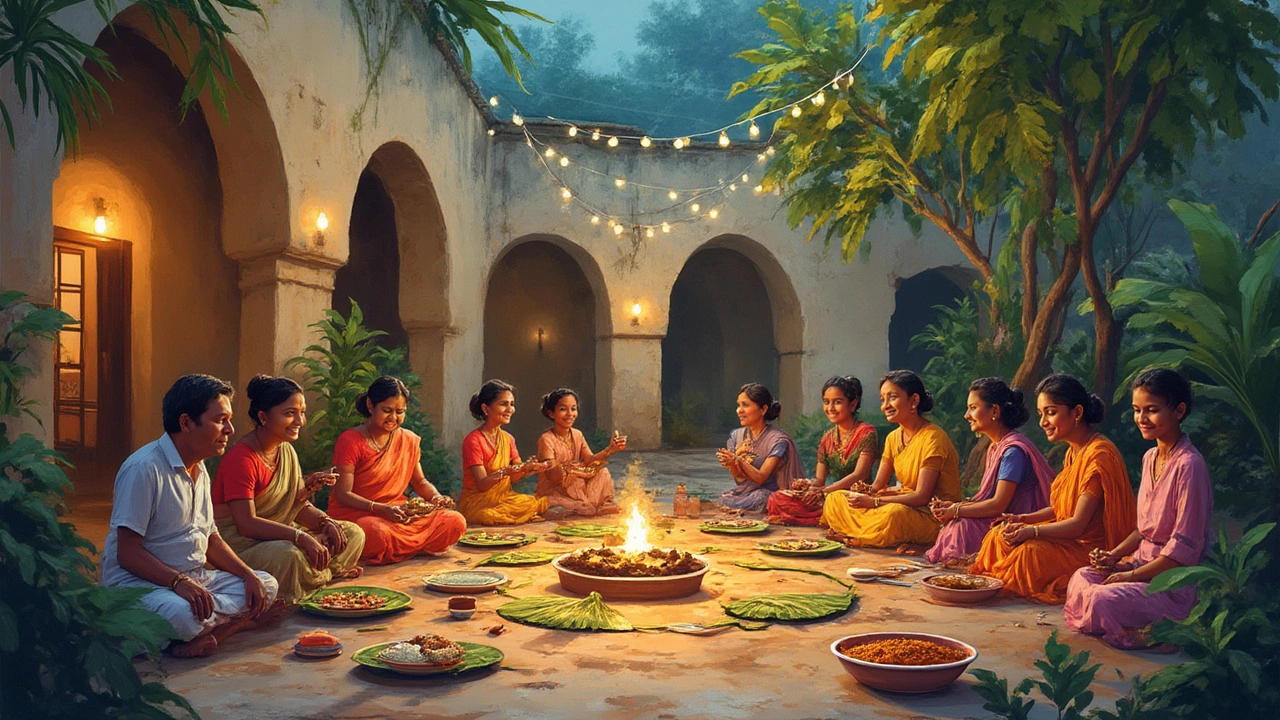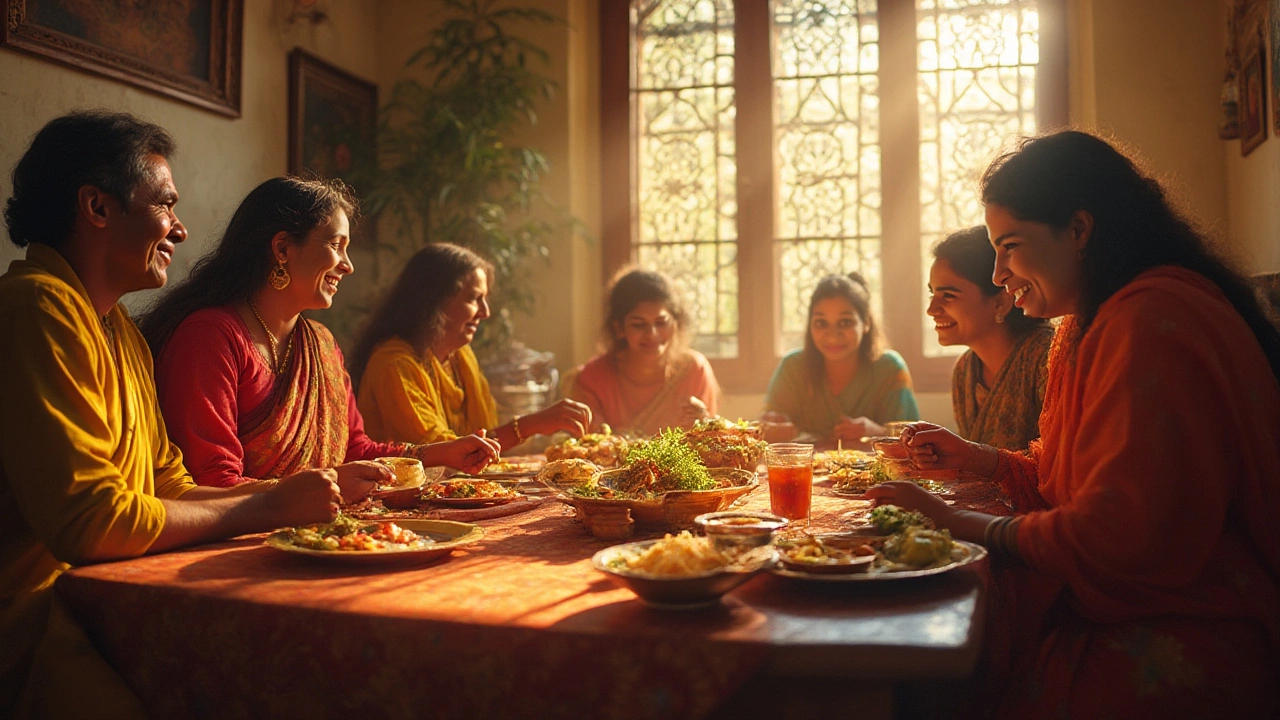Imagine you’re standing in a bustling Indian city. It’s noon and the smell of spices hangs thick in the air. Restaurants are packed, tiffins clatter as office-goers unpack homemade food, and street vendors work up a frenzy. But late at night, families gather at home, plates heap up once more, and laughter carries through open windows. This tug-of-war between lunch and dinner isn’t just poetic — it’s real, rooted, and depends on where you are in India. So, what actually counts as the main meal of the day in India? Let's cut through the assumptions and see how the answer shifts if you move from Mumbai to Kolkata — or, honestly, from one apartment block to the next.
The History Behind India’s Main Meals
Let’s roll back a hundred years. If you visited a typical Indian household in the 1920s, your answer to "what’s the main meal?" wouldn’t have been so simple. In rural areas, and across most of northern and central India, lunch was king because people rose with the sun and spent hours working on farms. After a hard morning, a hearty midday meal fueled the rest of the day. This is why classics like dal, sabzi, rice (or roti), and pickle formed a complete lunch, eaten together as a family, usually sitting on the floor or a simple woven mat. Dinner? That was much lighter, almost perfunctory.
But Indian cities weren’t stuck in the same routine. As railways expanded and the British influence grew, office hours arrived. Office-goers began eating lighter lunches or carrying meals with them, saving their real feast for when everyone returned home. This is where the whole "dinner is the main meal" idea started to creep in for city dwellers. For the working class and traders (like in Gujarat and Maharashtra), lunch remained significant, but urban professionals gave dinner newfound importance because it was the only time families could unite and unwind.
Even religion played a role. Hindus often prefer not to eat non-vegetarian food during the day; they save it for dinner. By contrast, some regions in the south and east stick with substantial lunches, echoing agricultural life. And let’s not forget the weather: hot climates push big meals earlier in the day to make digestion easier, while cooler northern states can handle hearty evening eats. So, history set the stage — but it’s still being rewritten every day.
Lunch or Dinner: How Region and Culture Decide
Here’s the thing: ask 10 Indians about their main meal, and you’ll probably get 11 different answers. But some patterns do pop up. In states like Kerala, West Bengal, and Andhra Pradesh, lunch is still the undisputed champion. Want proof? Just check a typical lunch table in Kerala: rice at the center, surrounded by sambar, thoran (stir-fried veg), meen curry (fish), pickle, papadum, and buttermilk. All served in generous portions, with everyone digging in around 1 pm — often followed by a well-deserved nap.
Travel north to Punjab, Haryana, or Rajasthan, and things get blurrier. Families eat heavy lunches (think stuffed parathas, milk-rich curries, and dal makhani), but over the past 50 years, dinners have also become major events, especially on weekends or after social gatherings. Urban life in Delhi, Mumbai, or Bangalore? Evening is when families truly sit together, since work and school keep everyone apart during the day. On the dinner menu: butter chicken, paneer tikka, rotis, biryanis, and elaborate desserts.
Digging deeper, here’s an interesting twist: among Indian Muslims (especially in Hyderabad), iftar during Ramadan turns dinner into a grand celebration, featuring haleem, biryani, and sweet treats. Festivals also play a wildcard role — South Indian Onam Sadya is a spectacular daytime feast, while Diwali in north India means heavy involvement of both lunch and dinner banquets. It’s almost as if India refuses to pick just one main meal, enjoying the flexibility to feast at any hour.
To make sense of it all, check this table showing meal patterns in different Indian regions:
| Region | Main Meal of Day | Typical Foods |
|---|---|---|
| Kerala | Lunch | Rice, Sambar, Thoran, Fish curry |
| Punjab | Both Lunch & Dinner | Parathas, Dal, Curries, Paneer |
| Mumbai (urban) | Dinner | Chapati, Dal, Sabzi, Pav Bhaji |
| West Bengal | Lunch | Rice, Fish curry, Shukto, Mishti |
| Hyderabad | Dinner (esp. Ramadan) | Biryani, Haleem, Kebabs |
| Tamil Nadu | Lunch | Rice, Sambar, Poriyal, Rasam |

Modern Influences: How Work, Lifestyle, and Globalisation are Changing Indian Meals
Fast forward to 2025, and my own house in Birmingham mimics India’s trendiest metro cities. My dog Zoya knows she’ll get table scraps at dinner, not lunch — and that’s no accident. Students, IT workers, and professionals gobble a quick sandwich or salad at lunch and save their proper Indian food (think rajma chawal or chicken curry) for dinner. This is thanks to packed schedules, long commutes, and work-from-home shifts.
Even in Indian cities, this shift is obvious. Uber Eats reports showed a whopping 65% jump in dinner orders post-pandemic compared to lunch. Time-strapped millennials prefer fuss-free noon meals, leaving the main event for evenings. Nuclear families, late-night Netflix binges, and 9-5 jobs have made dinner the big meal in places like Bangalore, Hyderabad, and Pune.
Yet the classic Indian lunch — thali style — hasn’t vanished. Rural India, smaller towns, and joint families still treat lunch as the most important meal. Government school mid-day meals for kids still emphasize lunch for better nutrition, which shows how the tradition holds. Some nutritionists even argue lunch should be the largest meal, since the metabolism peaks during the day. Here’s a surprising tip: in Ayurvedic practice, lunch matches the body’s peak digestive time. That’s why health-conscious folks in India are returning to bigger lunches and lighter dinners for better sleep and energy.
But there’s no one-size-fits-all formula. Multinational work cultures, fitness fads, and Western brunch cafes have blurred the lines. Salad bars and smoothie bowls are now a lunch thing in metropolitan neighborhoods, while traditional curries and rotis make a comeback for dinner to satisfy nostalgia. Indian food, ever-adaptable, always finds a way to thrive — no matter the hour.
So, What Does the Main Meal Look Like Today?
So where does this leave us? Whether you’re in Chennai or Birmingham, the main meal of the day in India is a bit like choosing your favorite song from A.R. Rahman — there’s hardly a single answer. Lunch is typically bigger in rural, traditional, or southern homes where mid-day heat and family routines still shape eating habits. Dinner has climbed the ranks in urban, northern, or western metros, especially for those with busy workdays or school schedules.
Here are some cool facts and handy tips if you want to eat like locals:
- South Indians favor a hot, heavy lunch — try making sambar rice with a generous side of coconut chutney for an authentic experience.
- North Indians go for cheerful dinner spreads. Paneer butter masala and naan are popular, but the humble dal roti combo is still a weeknight favorite.
- If you’re in India or planning a dinner party inspired by Indian traditions, match the meal to the occasion. Vegetarian thali for lunch, or a slow-cooked mutton curry for dinner, both work — but don’t serve heavy fried foods late at night if you want good sleep!
- On festive days, extravagant meals happen at **both** lunch and dinner. Indian kitchens really turn into creative playgrounds during Diwali, Onam, Eid, or Holi.
- Trying to eat healthy? Nutritionists suggest eating a bigger lunch and a lighter dinner. This fits the traditional Indian rhythm, and you’ll notice your energy lasts longer through the day.
No matter where you sit on the lunch-versus-dinner debate, one thing is constant: Indian meals are about more than food. They're a celebration — of seasons, harvests, families, and history. It’s less about which meal is ‘main’ and more about the joy of sharing. That’s probably why, in my home, Zoya always gets a seat next to my chair — she knows every meal, big or small, just brings us all together.
